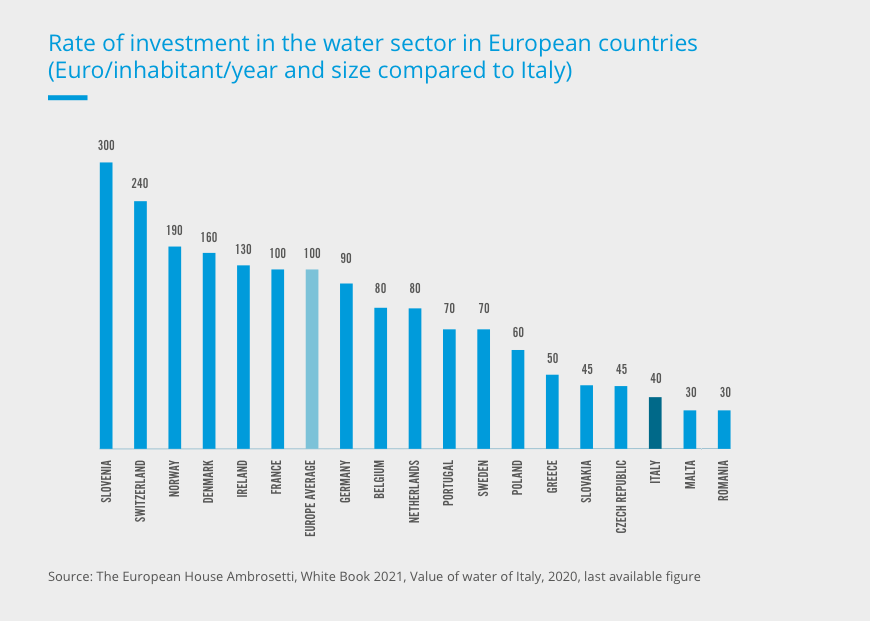Introduction
Introduction
Investments in the water sector
Since its founding, the HERA Group has invested an average of 111 million euro per year in the water cycle (maintaining this commitment even at the peak of the economic crisis and the health emergency periods). In 2020, investments totaled Euro 166.1 million. More specifically, 59% has been invested in mains water network, 24% in sewerage systems and 17% in water purification treatments.
Including works carried out or financed by asset companies, 188.4 million euro have been invested in the area served by Hera, i.e. 52 euro per capita. In the three-year period 2018-2020, 53 euro per capita have been invested compared to a national average of 40 euro per capita and a European average of 100 euro per capita invested in 2018 (source: The European House Ambrosetti, White Book 2021, Value of water of Italy, 2020, last available figure).
With 40 euro per inhabitant per year (compared to a European average of 100 euro), Italy is at the bottom of the European ranking for investments in the water sector, ahead only of Romania and Malta (source: The European House Ambrosetti, White Book 2021, Value of water of Italy, 2020, last available figure).

Evolution of the European legislative on drinking water
On 16 December 2020, the European Parliament approved the new EU Directive 2020/2184 on the quality of drinking water for human consumption which updates the previous directive 98/83/EC of 1998 by repeal and subsequent revise.
The new directive, which came into force on 12 January 2021, must be implemented by the Member States within two years of its entry into force. Therefore, the controls on the quality of water intended for purification and subsequent human consumption are still regulated by Italian Legislative Decree 31/2001 as amended.
The objective of the new directive is to protect human health from the adverse effects deriving from contamination of water intended for human consumption by not only reviewing and updating the current parameters but also by introducing a risk-based approach. This last element fully adopts the principles long promoted by the World Health Organisation regarding the preventive risk assessment along the entire drinking water chain through the use of Water Safety Plans, for which it defines the development timelines. In this way, EU Directive 2015/1787 is completed and reinforced.
The new directive is part of the Sustainable Development Goals (SDGs) of the UN Agenda 2030. In particular, it constitutes a commitment made towards Goal no. 6 "Ensure availability and sustainable management of water and sanitation for all" and it is the first European legislation adopted following a European Citizens Initiative (instrument of participatory democracy of the European Union) called "Right2Water". This initiative collected almost 2 million signatures and pushed the European Union to draft the text of the directive, which was then approved by the Council and the European Parliament.
In addition to various changes made to the previous directive related to scientific progress and in order to improve the safety of the distributed water, particular attention has been given to the measures necessary to improve or maintain access for all to water intended for human consumption (art. 16) and to ensure the availability of adequate and up-to-date information to the public (art. 17). In fact, according to the directive, in order to make consumers more aware of the implications of water consumption, they should be able to receive information in a simple and accessible way (e.g. in the bill or through a smart app) on the volume consumed annually and its evolution, as well as a comparison with the average consumption of households, where such information is available to the water service provider, and the price per litre of water for human consumption, in order to permit a comparison with the price of bottled water. The standard intends to increase and improve the trust of citizens in tap water by reducing the production of waste deriving from the consumption of packaged water.
The new directive introduces a series of modifications including the updating of the water quality standards, by setting stricter limits on contaminants to make the drinking water even safer. The update of the parameters and relevant limits (Annex I of the directive) was made based on the update of the Guidelines on drinking water of the World Health Organisation, to which was applied a strong precautionary principle.
Published since 2009, the “In buone acque” (In good waters) report is entirely in line with this new legislative intervention by the new European Directive by anticipating by fully 12 years the European request for greater transparency on the quality of tap water to increase public trust.
Water Safety Plans (WSPs)
|
The 2020/2184 European Directive concerning the quality of water for human consumption introduced the methodology for the Water Safety Plans (WSPs) for the structuring of prevention and control activities aimed at ensuring better quality of drinking water. |
